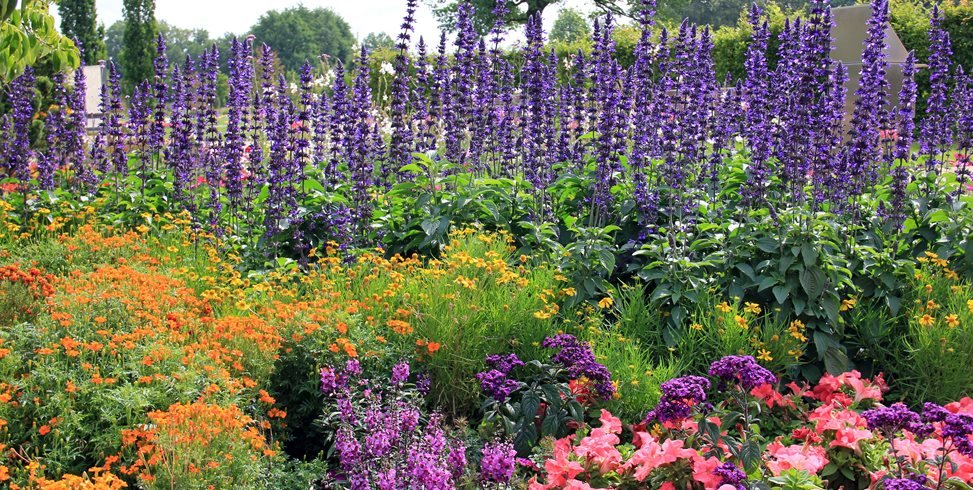How to Grow an Amazing Flower Garden
To have an amazing, vibrant garden full of flowers that are in bloom all year round, there are many things to take into consideration. It is important not only to know what type of plants and flowers you want but also where they should be planted, the conditions needed for their survival, and protection from pests or other problems.
This article will help walk you through each step so that your flower garden can be the envy of everyone else’s. Keep reading to learn more.

Image Credit: http://gardendesign.com
How to grow an amazing flower garden
1. Make sure your soil is healthy
One of the most important things to consider when planting flowers is the quality of the soil. All plants need some type of nutrients to grow and thrive, and the soil provides these essentials.
If your soil is poor or has a lot of clay in it, you will need to add organic matter such as compost, peat moss, or manure to make it more hospitable for plant growth. You can also purchase fertilizer specifically designed for flower gardens, which will provide everything your plants need.
2. Choose the right type of flowers for your garden
Not all plants are suited for every climate or growing condition. Some flowers thrive in full sun while doing better in partial shade. Some like to grow in rocky, sandy, or clay soil while others prefer rich, moist dirt. Before you start planting your garden, choose some plants that are appropriate for your area of the country so they can get all of the nutrients they need to survive.
Thebest evergreen plants to grow in a flower garden are:
Morning glory (Ipomoea purpurea) – A vigorous vine that is easy to grow and produces lovely trumpet-shaped flowers in shades of blue, purple, pink, or white. It blooms all summer long and can be grown as a climbing plant or trained to grow on a trellis.Confederate Jasmine (Trachelospermum jasminoides) – This vine produces clusters of fragrant white flowers that bloom all summer long. It grows best in full sun or partial shade and can be used to cover an ugly fence or wall.Trumpet Creeper (Campsis radicans) – This fast-growing vine is covered with large, trumpet-shaped flowers in shades of red, orange, or yellow in the summer. It thrives in full sun but can grow in partial shade as well. It needs a structure to climb on and will need regular pruning to look its best.
Thebest shade-loving plants to grow in a flower garden are:
Coral Bells (Heuchera spp.) – This easy-to-grow perennial produces pretty blooms and is an excellent choice if you want to color in your shade garden. It blooms in spring and fall with shades of red, pink, white, or coral and will tolerate just about any soil type.Jacob’s Ladder (Polemonium caeruleum) – A delicate, foliage plant with beautiful bell-shaped flowers that come in shades of blue, purple, or sometimes even pink. It tolerates partial sun but prefers shade and moist soil where the roots can spread out.
3. Planting flowers in a pattern can create an amazing design
There are many ways to plant flowers in patterns and designs so that you get beautiful results without having to try too hard. You can line plants up along paths or sidewalks with different colors of blooms at each end for a simple but impressive decoration. If your garden is on slopes, you might want diagonal rows following the hill instead of side-by-side lines. These kinds of flower gardens will add interest to any outdoor setting.
4. Mulch around plants to keep them healthy and prevent weeds from growing
Mulching is the process of adding a layer of organic or inorganic material around plants to protect their roots, retain moisture and suppress weed growth. It is especially important to mulch around newly planted flowers until they are well established. You can use shredded bark, straw, leaves, grass clippings, or any number of other materials for mulching.
5. Add some water into the ground to help with plant growth, but don’t over-water.
Container gardens need more frequent watering than those planted in the ground since the soil in containers dries out more quickly. But be careful not to overwater, as this can cause root rot and kill your plants.
TIP: One of the best ways to water flowers in a container is to water from below by setting the flower pot in a larger container filled with water. This way, the roots won’t sit in soggy soil which can also cause them harm.
6. Design your garden around something special
If there’s a favourite place you’d like to highlight or a particular view that you want to enjoy while tending your garden, think about how you can bridge it into your design so that it becomes an integral part of the overall look. Flower gardens work well when they are set near benches or loungers where people can relax among nature and admire their hard work.

Image Credit: http://gardendesign.com
Other factors to consider
When designing a flower garden, there are a few other factors to take into account, such as:
The amount of sunlight the area gets – Flowers need at least 6 hours of sunlight per day to grow and bloom properly.The soil type – Not all flowers do well in all types of soil. Make sure to check the requirements of the plants you choose.Drainage – Poor drainage can kill plants quickly, so make sure your flower garden has good drainage before planting.
All of this information can help you create a beautiful and unique flower garden that will be enjoyed for years to come. With a little bit of planning and some thoughtful design, you can have the garden of your dreams.
How To Grow An Amazing Flower Garden – FAQ
What type of soil should I use to garden with flowers?
Good-quality topsoil is always a great option when planting any kind of flower. If you don’t have access to topsoil, you can also create your mix by combining equal parts of compost, sand, and clay.
What are some good flowers to start a garden with?
There are a lot of different flowers that can be planted in a garden, but some of the most popular varieties include roses, lilies, sunflowers, and daisies. Be sure to choose flowers that are suited for your climate and growing conditions.
How often should I water my flower garden?
It’s important to keep your flower garden well-watered, but you don’t need to water it every day. A good rule of thumb is to water your plants when the top inch of soil feels dry to the touch.
What should I do if I see pests or diseases in my flower garden?
If you notice any pests or diseases affecting your flowers, take action immediately to get rid of them. You can usually treat pests and diseases with organic or chemical pesticides, or by using natural methods such as soap spray or garlic oil.
Final thoughts on how to grow an amazing flower garden
In conclusion, there is so much more that goes into a flower garden than just planting seeds and watching the flowers grow. Even if you have green fingers, there’s still some planning and preparation involved to get those beautiful blooms that we yearn for. Remember that each plant has specific needs, whether it be water or sunlight, and provide them with what they need.
The post How to Grow an Amazing Flower Garden appeared first on Kitchen Infinity.
Did you miss our previous article…
https://public-kitchen.org/?p=822


